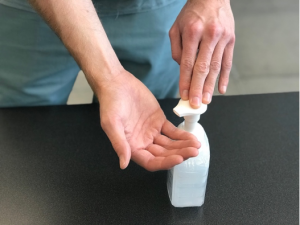Alcohol-Based Hand Rub (ABHR)
When performing hand hygiene using the alcohol-based hand rub technique, a liquid, gel, or foam alcohol-based solution (e.g., ethanol, isopropanol, or combination) is used. The ABHR is the preferred method to use when your hands are not visibly soiled to reduce the number of most transient microorganisms on your hands, and is more effective than washing hands with soap and water (PIDAC, 2014).
Benefits of ABHR:
- Kills the majority of microorganisms (including viruses) from hands.
- Requires less time to use than soap and water (20 to 30 seconds).
- Are easy to use and have high levels of availability at the point of care (e.g., where three elements occur together: the client, the healthcare provider, and care involving the client).
- Provides better skin tolerability and reduces skin irritation because it contains emollients (PIDAC, 2012).
You should perform hand hygiene with an ABHR in front of the client prior to beginning and at the end of the examination. The ABHR should have 70–90% alcohol concentration (PIDAC, 2014).
Clinical Tip
Alcohol-based hand rub (ABHR) is most effective when used correctly. The concentration should be 70-90%, the volume of the solution should cover all surfaces for your hands and wrists, and the solution should be rubbed into your hands for a minimum of 20 seconds and until your hands are dry. ABHR application should not take less than 20 seconds, be diluted with water, or be removed with a paper towel. Following these techniques increases the efficacy of ABHR.
Hand Hygiene with ABHR
Steps |
Additional Information |
1. Inspect hands for cuts and open sores, and cuticles for tears.Open cuts, sores, and abrasions should be covered prior to starting work.Inspect for visible soiling. If present, you need to wash your hands with soap and water. |
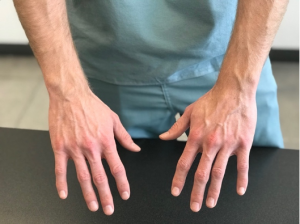 |
2. Remove all jewellery on hands and wrists.If a watch is worn, it must be moved high above the wrist or removed to provide access to your wrists to wash. |
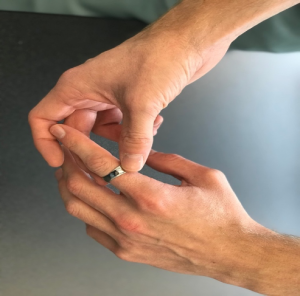 |
3. Apply 1 to 2 pumps of product into the palm of dry hands.Product should not be applied to wet hands, as this will dilute the product. Product should not be applied to visibly soiled hands.Enough product should be applied to thoroughly wet hands and fingers for the entire procedure of 20 to 30 seconds before drying.Always follow the manufacturer’s guidelines. |
|
4. Rub hands together, palm to palm.Rubbing hands together ensures palmer surfaces are covered by the product. |
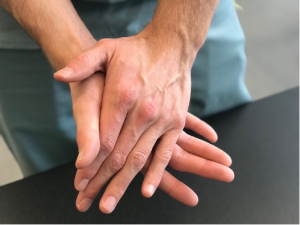 |
5. Rub the back of the hands.Rubbing the back of the hands allows all surfaces of the fingers to be exposed to the product. |
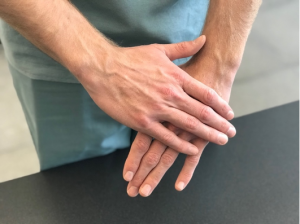 |
6. Rub the alcohol between all the fingers to cover all the fingers.Rubbing between the fingers allows all surfaces of the hands to be exposed to the product. |
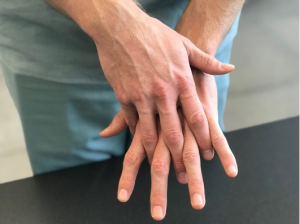 |
7. Press fingertips into the palm of the opposing hand and rub back and forth.Pressing the fingertips into opposing palms and rubbing ensures fingertips and nails are exposed to the cleaning product. Nails harbour more bacteria than do hands. |
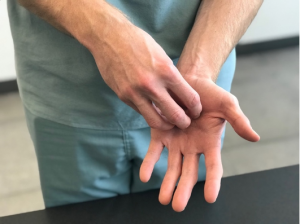 |
8. Rub each thumb in a circle in the palm of the opposite hand.Rubbing each thumb, from the base of the thumb to the top, provides complete coverage of the product on the thumb. |
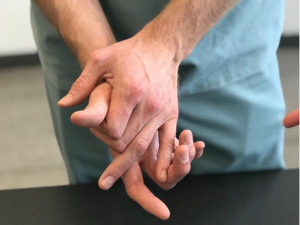 |
9. Rub hands together until they are dry.Rubbing hands together provides adequate time for the alcohol to dry. The minimum time required for proper rubbing technique when using ABHR is 20 to 30 seconds, and until your hands are dry.Do not use a paper towel to dry hands (your hands should dry from rubbing action). |
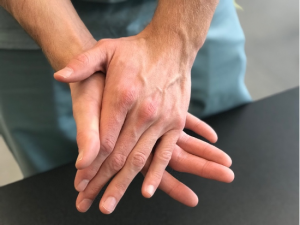 |
10. Hands are now safe to use.Hands must be completely dry prior to providing care, touching a client or their personal items, medical equipment, and environment. |
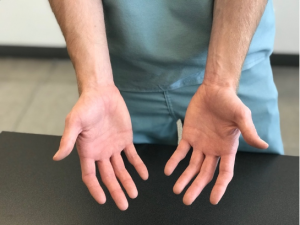 |
Source: PIDAC, 2012; PIDAC, 2014. |
Safety Considerations
- Do not use ABHR in combination with soap and water, as it may increase skin irritation.
- Use ABHR that contains emollients (oils) to help reduce skin irritation and over-drying.
- Allow hands to dry completely before initiating tasks (e.g., touch client or environment) or applying clean or sterile gloves.
- ABHR may be used for all four moments of hand hygiene, as long as hands are not contaminated or visibly soiled.
- DO NOT use ABHR if the client is suspected to have or confirmed with C. difficile, norovirus, or Bacillus anthracis. ABHR will not kill spore-forming pathogens.
Common Errors when Performing an ABHR
- Not letting it air dry (rubbing on your pants to dry it off).
- Shaking out your hands to dry.
- Applying too much alcohol-based solution.
- Not applying enough alcohol-based solution.
- Not rubbing hands long enough for a minimum of 20 seconds and until hands are dry.
- Skipping steps (e.g., fingernails, wrists, back of the hands, thumbs).
Common Errors |
Example |
It is important to wash your hands thoroughly before drying.The most commonly missed areas are circled in the photos which include: the base of your thumbs, fingertips, between your fingers, and the ulnar aspect of your hand.
|
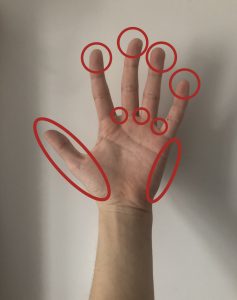 |
Remove all jewelry.Check your institution’s policy regarding watches, as institutional policies may differ.Your watch should be pushed above the wrist or removed. |
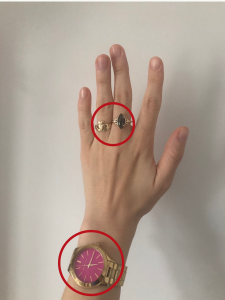 |
Nails should be short, with no nail polish or acrylic nails. |
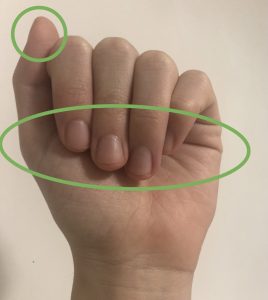 |
Points of Consideration: Cultural Practices and Hand Hygiene
Culture and religion can influence hand hygiene practices. For example, in Sikh culture, hand hygiene is considered a holy act and an essential element in daily life. Some religions are prohibited against alcohol use, therefore ABHR may be of concern for some clients and healthcare providers. However, most religions do not object to the use of alcohol-based products for hand hygiene. It is important to reflect on your own cultural practices to learn how they may impact your hand hygiene practices. It is also important to discuss cultural aspects of hand hygiene with clients to increase your awareness of their needs and potential for health promotion and education.
To learn more the handy hygiene practices amongst various cultures and religions, review WHO Guidelines on Hand Hygiene in Health Care on pages 78–85: https://apps.who.int/iris/bitstream/handle/10665/44102/9789241597906_eng.pdf;jsessionid=504F854FDB4477FD7539AF737E99B315?sequence=1
Test Yourself!
While watching the interactive video on ABHR, apply what you have learned by answering the questions throughout the video. Please note: there is no sound in this video.
Clinical Tip
Assist clients to perform hand hygiene. Some clients may need help due to their health status, e.g., clients diagnosed with arthritis or dementia. You can help by pumping the ABHR gel into the client’s hands or washing the client’s hands with a face cloth that has soap and water on it. Encourage and assist clients to perform hand hygiene before and after entering their rooms, eating, and toileting.
Test your Knowledge
Attribution
This page was remixed with our own original content and adapted from:
Clinical Procedures for Safer Patient Care — Thompson Rivers University Edition by Renée Anderson, Glynda Rees Doyle, and Jodie Anita McCutcheon is used under a CC BY 4.0 Licence. This book is an adaptation of Clinical Procedures of Safer Patient Care by Glynda Rees Doyle and Jodie Anita McCutcheon, which is under a CC BY 4.0 Licence. A full list of changes and additions made by Renée Anderson can be found in the About the Book section.
Physical Examination Techniques: A Nurse’s Guide by Jennifer Lapum, Michelle Hughes, Oona St-Amant, Wendy Garcia, Margaret Verkuyl, Paul Petrie, Frances Dimaranan, Mahidhar Pemasani, and Nada Savicevic is licensed under a Creative Commons Attribution-NonCommercial 4.0 International License, except where otherwise noted.

